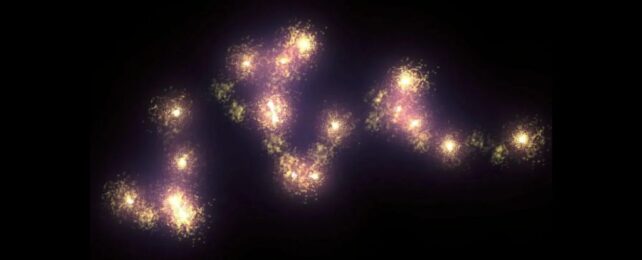The largest known structure in the Universe may be even larger than the large we thought it was.
A re-examination of the distribution of powerful space explosions suggests that the Hercules-Corona Borealis Great Wall, a cluster of galaxies previously estimated to be 10 billion light-years long, could actually be as large as 15 billion light-years in size.
That's not only mind-blowing in scale, but poses a huge challenge to our understanding of the Universe. The findings have been submitted for publication, and can be read on the preprint server arXiv.
The Hercules-Corona Borealis Great Wall (or Great Wall, for short) was discovered more than a decade ago, when astronomers noticed that gamma-ray bursts were happening in a concentration that was higher than the expected distribution.
Gamma-ray bursts are the most powerful explosions in the Universe, produced during extreme events such as the core-collapse supernova birth of a black hole and the collision of two neutron stars.
Since black holes and neutron stars both form from massive stars, gamma-ray bursts are associated with the populations of massive stars that are usually found in galaxies.
Because they are so bright, gamma-ray bursts can be observed across enormous distances, and their concentrations can be used as a proxy to map galaxy clusters. The study of 283 gamma-ray bursts is what led astronomers István Horváth, Jon Hakkila, and Zsolt Bagoly to report the discovery of the Great Wall in 2014.
Now, the three scientists have joined a larger team to conduct a more detailed study of gamma-ray bursts across the sky to try to get a more accurate sense of the scale of the Great Wall.
They have closely examined 542 gamma-ray bursts with known redshifts – that is, the extent to which their light has been stretched to redder wavelengths by the expansion of the Universe, thus providing a confident measure of distance.
Their results showed that the Great Wall may extend from a redshift of 0.33 to a redshift of 2.43 – a total distance of around 15 billion light-years (the observable Universe is around 93 billion light-years across).
It's a finding that makes the problem posed by the Great Wall even more pronounced.
This is because our standard model of the evolution of the Universe is founded on something called the cosmological principle. This states that, on large enough scales, the Universe is homogeneous, or 'smooth', in all directions.
Each section of the Universe should look more or less like every other section of the Universe, with no major inconsistencies or bumps. This has been confirmed by multiple lines of evidence.
A structure larger than around 1.2 billion light-years would be considered a major inconsistency, and we've found quite a few of those.
A super-structure called Quipu measures about 1.3 billion light-years wide, while the Sloan Great Wall spans around 1.37 billion light-years. The discovery of a similar structure called the South Pole Wall, also around 1.37 billion light-years across, was announced in 2020.
The Clowes-Campusano LQG group of galaxies is 2 billion light-years across, the Giant Arc is around 3.3 billion light-years across, and the Huge Large Quasar Group is 4 billion.
Then there's the Great Wall, which at 10 billion light-years across, was already an extreme outlier. The new results have upped the ante.
Previously, the Great Wall's entire existence was debated. The new results show that evidence of the structure is not a statistical fluctuation or a sampling bias. It appears to be very much real. What the data means beyond that – what the structure tells us about the Universe and its evolution – has not yet been explored.
However, what we do know is that there's a whole lot about the Universe that we don't know, and that we can't really make sense of yet.
Somewhere out there, the answers are waiting. It's discoveries like this that are inching us ever closer to finding them.
The team's findings have been submitted for publication, and are available on arXiv.
